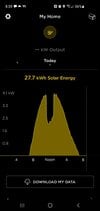I have the same setup with the Delta M4 inverter. If you notice, your peak is at 4 kW. I'm almost certain (not an EE, but am an engineer otherwise...) what's happening is that your inverter (and mine, check out my production from today in the image below) is receiving more DC power from the panels than its rated output, which is 4kW. Since my system is 5.44 kW installed in two strings, the only thing it can do is shut off one of the strings to prevent from overloading the inverter (you can see this in my second picture where the western string drops to 0 current over that time frame). This is called "clipping", and is not terribly unusual in solar installations (see
How much clipping for east/west solar?). The issue is that instead of the SolarEdge inverter with power optimizers that will reduce output on a per-panel basis, meaning the system can maintain 4 kW when it clips, the only thing the Delta inverter can do is shut off individual strings, which for my system is half it's capacity. Thus, the output at the best solar hours of the day drops to ~2.2kW.
I am extremely disappointed that this is happening, especially since I was quoted a SolarEdge inverter, and didn't realize they installed something else until they were pretty much done the installation (talk about bait and switch...). To me, this is unacceptable, and I've requested that they replace my inverter with a larger size to prevent this from happening (the cost of a 5kW inverter is ~$100 more, so effectively nothing in comparison to the cost of the system). Tesla cheaped out here, and we're paying the price with reduced production. They could have wired it in more strings (the Delta inverter supports up to 4), so it could be more granular when shunting off production, or could have sized the inverter higher to avoid this problem. I have been told I will hear back "shortly" after they've reviewed my request, so I'll try to keep this thread updated with what I hear.
View attachment 649830
View attachment 649832



